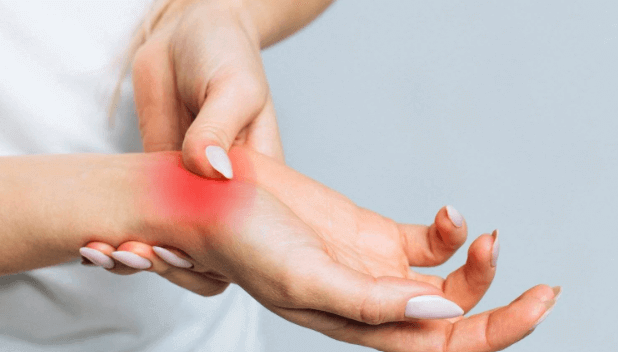
Sleeping Comfortably with Rheumatoid Arthritis
|
|
Tempo di lettura 5 min

Sleep is essential for our well-being, and we understand that a good...
|
|
Tempo di lettura 5 min
Rheumatoid arthritis (RA) irritates the lining of your joints, so they can feel sore, stiff, puffy and sometimes warm—especially after you’ve been still for a while. That’s why nights can be tough: you stay in one position, tissues tighten, pressure lands on tender spots, and pain or tingling wakes you. Common night-time discomfort includes deep aching in hips and shoulders, sharp pressure at knees and ankles, hand and wrist pain that makes it hard to “park” your arms, and heavy morning stiffness that only eases after you get moving. Broken sleep then turns the “volume” up on pain the next day and leaves you more fatigued.
The aim of this guide is simple: give you clear, kind steps that help tonight, plus easy changes that make sleep more predictable over the next few weeks. No jargon—just practical ideas you can try and keep.
This article is general information, not medical advice. Please speak with your rheumatology team about your specific plan.
Inflammation and poor sleep feed each other. If joints are irritated, pressure or awkward angles feel sharper and you wake more. If sleep is broken, your pain threshold drops and fatigue rises, so the next night starts harder. The goal is to gently break that loop: soften pain signals before bed, support joints so they’re not compressed, and give your nervous system a calm, repeatable wind-down.
Do this in any order that feels natural; the whole thing can take 10–15 minutes.
A short, repeatable wind-down is better than a perfect one you only do sometimes. Dim the lights, write one line of “tomorrow’s to-do” so your brain can let go, then do 60–120 seconds of relaxed breathing. If scrolling wakes you up, switch to audio (podcast/music) with the screen off.
RA Flare-Night Plan (about 15 minute
Tip: Keep this routine the same most nights—predictability helps your system settle faster.
Small changes here cut overheating and irritation, so you settle faster and wake less.
If your hands wake you, try this: rest forearms on a soft pillow so wrists are neutral; avoid tucking hands under your head or pillow. Keep covers light so they don’t press fingers into flexed positions. Some people benefit from light night-time wrist splints—ask your clinician if that fits your plan.

We’re not prescribing one “best” position. These are options many people with RA find easier to support well. Use the bits that help and ignore the rest.
Side-sleep support:
Back-sleep support: place a small pillow under both knees to reduce lower-back pull; rest forearms on a soft pillow to keep wrists neutral if hands ache.
Stomach-sleep (only if nothing else works): use the thinnest head pillow you can; tuck a slim pillow under the pelvis to limit low-back arch; turn slightly toward side-lying with a long pillow to reduce neck twist.
If your current pillow collapses quickly, you’ll spend the night chasing height and support. Compare a U-shaped body pillow for full surround support with a J-shaped body pillow for a slimmer footprint.
Seek advice if you notice new or rapidly worsening night pain, sudden hot/swollen joints, new numbness/weakness, or sleep disruption most nights despite these steps.
Before getting up, give joints a calm start: ten ankle pumps per side, five gentle fist-to-open cycles, three shoulder-blade squeezes, and two slow nose-to-ceiling nods. During the day, short movement “snacks” (2–3 minutes) every hour or two keep stiffness from building. Keep caffeine earlier, alcohol modest, and aim for similar sleep/wake times—even on weekends.
Free Resource: 7-Day Sleep Comfort Plan
Daily, doable steps to calm evenings and steadier sleep.
What’s the best sleep position for RA?
There isn’t one “best” for everyone. Many people find side-sleeping with a body pillow between the knees or back-sleeping with a small pillow under the knees easier to support well. The goal is neutral alignment and filling small gaps so joints are cushioned, not compressed.
Should I use heat or cold at night?
Use gentle warmth (warm shower or low-setting heat pack for 5–10 minutes) if joints feel stiff; skip heat if joints are already hot. If joints feel hot or inflamed, try a wrapped cool pack for 5–10 minutes before bed. Never sleep on hot devices or place ice directly on skin.
How does a body pillow help RA pain?
A consistent-loft body pillow supports shoulders, hips and knees in one go, reducing twisting and pressure points. It also makes it easier to return to a comfortable set-up after brief wake-ups.
My hands and wrists wake me—what can I do?
Rest forearms on a soft pillow so wrists stay straight rather than bent, and keep bedding light so fingers aren’t pushed into flexed positions. Some people benefit from light night-time wrist splints—ask your clinician if that suits your plan.
I wake from pain and can’t get back to sleep—any tips?
Keep lights low, do 1–2 minutes of calm breathing (inhale 4s • hold 2s • exhale 6s), and reset your pillow support. If you’re still alert after ~20–30 minutes, sit up somewhere dim and do something gentle (audio book, stretch), then return to bed when sleepy.
When should I contact my rheumatology team?
If you notice new or rapidly worsening night pain, sudden hot/swollen joints, new numbness/weakness, or persistent sleep disruption most nights despite these steps. This article is general information—ask your clinician about your specific plan.
If you need a stable, breathable pillow that makes alignment simple each night, explore the Sanggol® U-shaped and J-shaped designs.